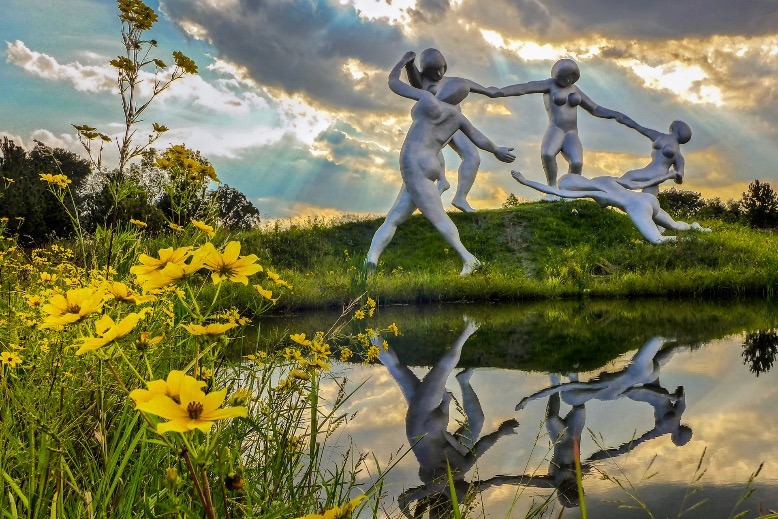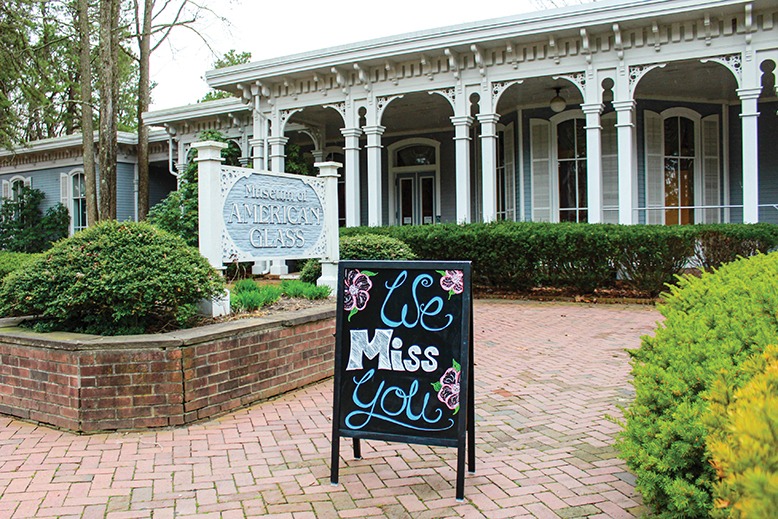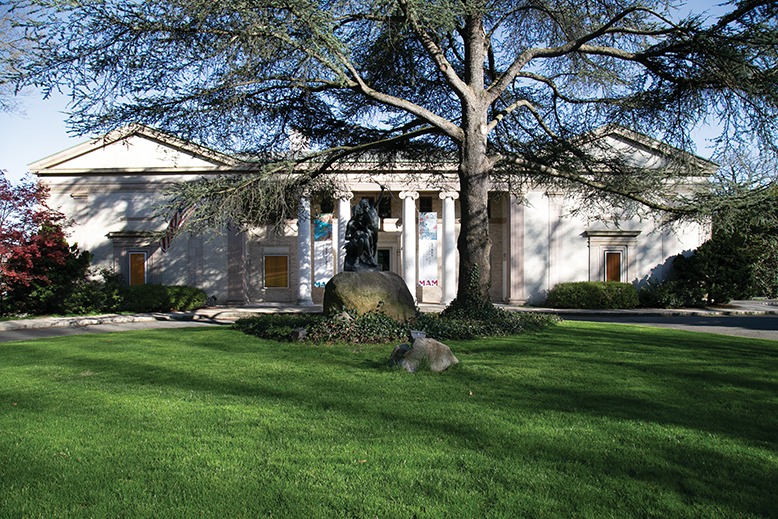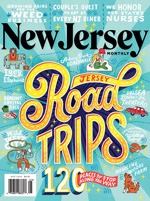
Seward Johnnson’s Daydream Photo by David W. Steele
On a typical spring Saturday, Grounds for Sculpture in Hamilton welcomes about 3,000 visitors to roam its winding pathways. These days, the sculpture park’s more than 400 human figures and abstract shapes sit alone, with only a groundskeeper to keep them company.
It’s the same across the state, where skeleton crews maintain dark theaters, mothballed museums and other dormant cultural centers that were mandated to shutter on March 16 to help stop the spread of Covid-19. At deadline of this story, most of the institutions were wondering when they would be allowed to reopen; some were wondering if they would ever reopen at all.
Arts and cultural organizations are accustomed to going dark for periods of time. But no one can remember an instance when all arts institutions in the state simultaneously ceased operation for months.
“Think about 9/11, the Kennedy assassination and the recession of 2008—these were moments in time,” says John Schreiber, president and CEO of Newark’s New Jersey Performing Arts Center. “This [is] an evolving crisis. No one can be sure at this time what to expect and what’s next.”
[RELATED: 7 Virtual Art Exhibits to Enjoy Right Now]
Months after chatter in theater lobbies was silenced, museum exhibition openings were halted, and arts-education programming migrated online, New Jersey’s best-loved cultural centers are crafting their contingency plans. Each is preparing for the unknown. Will they be allowed to open in June, later in the summer, in the fall, or not until 2021? They are looking for guidance from government and health officials, as well as Broadway (which is closed until at least September 6), the sports world and even places of worship. What new rules will they have to follow? How will they make visitors feel safe? What will be the financial toll?
During the last week of March, the New Jersey State Council on the Arts surveyed arts organizations and workers to gauge financial need in the sector at the height of the health crisis. The survey garnered 750 responses in five days. The results were grim: To survive a 90-day shutdown, organizations would need $30 million collectively.
In a statement, the board of the New Jersey Association of Museums added context: “This crisis will have lasting financial and operational considerations for not just months, but years to come.”
* * *
To mitigate their losses, seasonal arts centers in particular had to act fast. Almost immediately upon learning of the statewide lockdown, Grounds for Sculpture furloughed nearly 95 percent of its staff. By May, just four staff members, including executive director Gary Garrido Schneider, remained, all working on 40 to 60 percent salary reductions. Since 65 percent of the cultural center’s income is revenue—earned from ticket sales, the onsite Rat’s Restaurant, cafés throughout the park, education programs and rentals, management is projecting a $2 million loss if Grounds for Sculpture remains closed through July.
Although drastic, the staff furloughs at most institutions were done with an eye on long-term survival. The Grounds for Sculpture team focused on the questions, “How do we hibernate until we can reopen and make sure that we still have money to pay people when we start back up?” says Schneider.
Upon reopening, Schneider predicts visitor limits may be capped at 500–1,000 patrons daily and admission fees may need to be reduced. The 42-acre outdoor museum gives visitors “breathing space,” says Schneider. “And I think it’s the kind of experience people will be looking for when we’re able to get back outside.”

The Museum of American Glass at WheatonArts Courtesy of Wheaton Arts and Cultural Center
Similarly positioned to offer social distancing in an arts environment is Wheaton Arts and Cultural Center in Millville. The 45-acre open-air campus boasts the Museum of American Glass, interactive artist studios and gift shops. “People can wander,” says executive director Susan Gogan, “but we’re in a holding pattern.”
The center’s spring season was scheduled to launch April 1. Since then, they’ve postponed or canceled all programming through June, including their 50th anniversary gala and visiting artist series.
Future WheatonArts events pose problems as well. Last October, the Festival of Fine Craft attracted more than 12,000 people over two days. That turnout is unlikely this year. “We’re already at risk,” says Gogan, “so to plan something where you could potentially lose money is a concern.”
To save money and ensure social distancing, WheatonArts took the unusual step of turning off the furnaces in the glass studio. “I don’t think there’s ever been a time, other than maybe when we were in [Hurricane] Sandy’s path, that we turned anything with natural gas off,” says Gogan.
Before the lockdown, the center projected about $860,000 in income from April to June, including grants. They now expect a net loss for the period.
Although the center held back their annual donation appeal—“it just felt insensitive to send when other groups are raising money for personal protection for health care”—Gogan reminds people that arts centers are “treasures that need to be protected.”
* * *
Museums are especially concerned about a fall-off in contributions from loyal donors, normally a reliable revenue stream.
“It’s that philanthropy that is going to make or break institutions like museums in the next several years,” says Cleveland Johnson, executive director of the Morris Museum. “Will their support be diverted to other things? Are they going to recognize that arts and culture still need that support? Will it be seen as a priority?”
Most of the Smithsonian-affiliated museum’s income comes from foundations, corporations and individual donors. This year, some supporters expedited delivery of funds and have been willing to consider reallocation of project-specific funding for operating expenses.
This spring, it was the Morris Museum’s turn to host the juried New Jersey Arts Annual. Instead, that exhibit was rolled out online, with information and multimedia content about the artists and their work shared daily on social media. When the museum opens again, “we will reset the clock,” says Johnson. That exhibit and others will stay open for three or four months.

The Montclair Art Museum Photo by Laura Baer
The Montclair Art Museum is in a similar situation. MAM’s spring exhibitions, which opened in February, will be extended to the fall.
Shifting dates is relatively easy. Making cuts to staff and expenses is not.
“We had to cut as much as possible, which was extremely painful, to make sure there was a museum on the other end of this,” says MAM director Lora Urbanelli. That meant temporarily reducing regular employee headcount from 52 to 22. Those who remained are on part-time hours, including Urbanelli. Even with the building closed, expenses remain, including HVAC (the artwork must be kept at a certain temperature) and insurance.
MAM has also shifted to virtual offerings. “I think that’s going to serve us well, even when we get back in gear in a more normal way,” says Urbanelli.
Among MAM’s digital initiatives is the Jersey Artist Marketplace, a multiple-pronged fundraiser for artists, the museum, and to-be-announced partner agencies. All proceeds will be shared: 50 percent to the artist, 40 percent to the museum, and 10 percent to partners. “It’s great for the artists who really have seen a drop in their ability to stay visible and sell their work,” says Urbanelli.
Independent artists have been hit hard by the shutdown of galleries, which are sometimes their only path to exposure.
Molly Sanger Carpenter, a mixed-media artist based in Mannington Township, was counting on exposure and money from her May solo show at SOMA NewArt Gallery in Cape May. Instead, the exhibit was presented virtually, with curbside pickup of purchased works.
“As an artist, sure, you do it for money,” she says, “but you also do it because there’s something about getting your work out there in front of people and making your statement.”
Carpenter also does secretarial work for her husband’s landscaping business. Thanks to income from that hustle and an upcoming commission for the Joint Health and Sciences Center in Camden, Carpenter has not had to apply for loans set up for artists. “I know there are artists that are in worse straits than I am,” she says. “I have food in my refrigerator, and I’m able to carry on.”
The New Jersey Theatre Alliance has also helped creatives with short-term financial issues. The organization created a relief fund to assist workers affiliated with member theaters while they wait for unemployment checks. The fund provided $60,000 in grants to about 105 workers.
“We wanted to get some money into their hands as quickly as possible,” says John McEwen, executive director of the Alliance. “That could make the difference of making a rent payment, groceries or gas in the car.”
Nicolette Lynch, an actor and teaching artist for Luna Stage in West Orange, was among the recipients. “[It’s] very exciting,” says Lynch about the grant. “We live in that sort of not-knowing as performers,” she says. “Our lives can change instantly, so we’re adaptable.” But these are different times. Lynch, who is also the managing director for Newark’s Yendor Theatre Company, was relying on her Luna Stage income for the coming months. The temporary closure of the two companies has been jarring, says Lynch. “Our work is people,” she says about being an actor. “It’s people in terms of how to execute and in terms of who receives it, who benefits from it.”
* * *
It’s difficult for performing arts centers to predict what protocols will need to be rolled out when patrons can return.
Perhaps social distancing will still be in effect and masks will be required. Some institutions may choose to take patrons’ temperature at the door. “What we want to do is take it very slow,” says NJPAC’s Schreiber. “There is no rush to reopen; there can’t be, because people’s health is on the line. That’s what’s paramount.” That’s not to say that NJPAC, which has rescheduled or canceled about 150 shows due to the shutdown, isn’t eager to greet the public again.
While theaters discuss how to bring people back into close quarters, they are also looking at other options, including live-streaming new performances.

Paper Mill Playhouse Photo by Laura Baer
“It’s a highly complicated issue,” says Mike Stotts, managing director of Paper Mill Playhouse. Artists will need to be compensated appropriately, but also, “there is nothing that can really be done to replace the experience of doing a live show in front of a live audience,” he says. “It is very difficult to try to achieve that with social distancing. Can it even make sense for our kind of business? I have great doubts about it. And financially, I’m not sure it makes sense.”
Stotts cautions: “I fear that it will take a long, long time for our industry to recover, because already [it’s] pretty much hand to mouth.”
Ironically, a previous financial crisis of its own in 2007 left Paper Mill better prepared than others to endure the current emergency. That crisis nearly shut down the theater. Instead, it emerged from the ashes with a retooled business model that has allowed the organization to build a reserve fund, which is coming in handy now, while revenues have stalled. As of the beginning of May, the 60-person full-time staff had not been furloughed. “But the reserves aren’t endless,” warns Stotts, “and we need to reserve whatever we can for whenever we restart, because that will take another infusion of capital.”
The Covid-19 shutdown cost the theater two productions, as well as its annual fundraising gala. Altogether, those hits have resulted in a loss of about $5 million. The hope is that patrons will donate show tickets back to the company. For the gala, which nets about $930,000, Paper Mill expects to get more than half of the money in contributions from people who would have paid for tables.
* * *
Despite all the pain and uncertainty the coronavirus has caused for the state’s arts institutions, they can take heart in the appetite for culture that audiences have shown while sheltering at home. They’re listening to music, reading, exploring creative online content, and acting out skits, says McEwen. “We can’t forget the unique contribution that we make to the public. Not only now, but always.”
McEwen predicts traversing this new way of operating will take time and some trial and error. “But I do believe theater and the arts in general will be back because it’s something people need,” he says, “[It] makes such an impact on people’s lives, on their mental health, on stretching that imagination muscle. It helps us learn about ourselves, learn about each other. It’s something people crave.”
